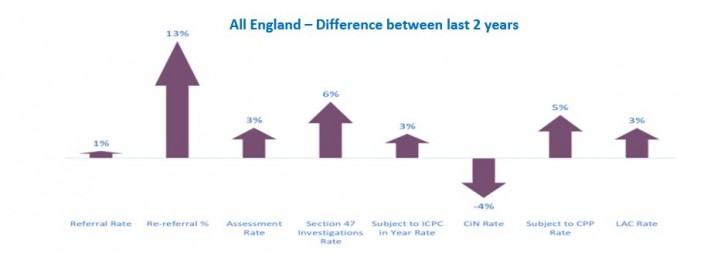This blogpost was co-written by Leo Jones.
The National Audit Office (NAO) has published its report exploring pressures on children’s social care, the response of national and local government to increasing demand, and an analysis of what is causing variations in demand between local authorities. The NAO’s report was rightly honest, holding up a mirror to the Department for Education (DfE) – where policy is made – and to local authorities. The NAO has laid the challenge to deal with the pressures firmly at the DfE’s feet.
The NAO suggests that the DfE does not know how much money is needed for children’s social care because it does not understand pressures and variation in the sector. It also casts doubt on whether the DfE can achieve its objective of ‘all vulnerable children having access to high-quality support by 2022’.
While these findings are not a surprise to us given our own Valuing Care analysis, the report’s recommendations are timely, and must now lead to action. The recommendations for the DfE include:
- Commission research to understand:
- what drives demand for children’s social care, using the individual child-level data that it holds
- the variations between activity levels in different local authorities
- Set out how it will reduce unnecessary variation in levels of looked-after children
- Assess how best it can work with local authorities to match children’s needs with residential children’s home capacity
- Assess whether its reliance on Ofsted’s assessments of the quality of children’s social care gives it the information it needs to secure more cost-effective children’s social care.
It is clear from Safeguarding Pressures report, published by the Association of Directors of Childrens Services (ADCS), that pressure is increasing across the system at the same time as budgets continue to fall. More and more local authorities are openly talking about the hard choices they are facing to balance the books, with some now actively reducing early help provision even though they know this will increase pressure on statutory support further down the line.
Money is clearly a key issue and no-one should pretend it isn’t. The repeated budget cuts of the last decade have been hard, and local authorities are now struggling to find new ways of making further savings. Nationally, there isn’t enough money in the system to meet current levels of demand, as the ADCS report clearly demonstrated. In addition, the way funding has been historically distributed to the sector means that reduced central government funding has had a much more profound effect on some authorities than on others.
There are some success stories. In 2017/18, Lincolnshire County Council had 45 looked after children per 10,000 against a national rate of 64, and have not seen a significant rise in demand over the last few years despite a rising population and central government cuts. Other authorities including Derbyshire, Hertfordshire and Ealing can all tell a similar story. Essex is a beacon of exceptional social work practice, which is resulting in great outcomes for children and reduced demand for services.
The IMPOWER INDEX enables councils to see which authorities are spending their money most effectively and getting the best outcomes for citizens. Demand for children’s services in 2017/18 was lower in Essex than amongst their statistical neighbours:

This praiseworthy performance is in marked contrast to the overall national trend, which is that demand is increasing almost across the board.

It is clear that there continues to be great disparity in performance between authorities. We have seen this in our own work with authorities across the country; some are managing demand and cost well, while others are seeing both spiral out of control. When combined with the reduction in central government funding, the result is toxic.
Our work has proven that producing better outcomes for citizens should cost less. Achieving better outcomes requires shaping public services that identify issues early, and work in an integrated fashion to intervene quickly, rather than just assessing problems when they arise. It requires adapting to the changing landscape of local public services, and recognising that the challenges to be addressed by councils are not just those that can be controlled. Public services are complex systems, with problems distributed across functional and organisational boundaries. By definition such problems are not easily predictable or easy to respond to. Leaders in local government need to exercise control where they can, but also seek to influence the factors they cannot directly control.
Because the main debate about children’s social care focuses on the amount of money it receives, there is insufficient discussion about how that money is best spent. Rather than discussing service efficiency, there is a need to analyse outcome productivity, determining how much value has been generated from the public investment made in children’s services.
In light of the NAO’s analysis, the Treasury may well want to see evidence of how additional funds will really impact children’s lives and will tackle the variation in children’s services. It is time for an open debate on where additional investment is best targeted and how its impact should be evidenced.
The system is clearly in crisis, so something has to give. A focused review of those local authorities that are producing the best outcomes at less cost than others should be a top priority. This would need to involve Directors of Children’s Services from local authorities where demand is rising, as well as those where they have managed to control it. Such a review is vital to inform the future spending requirements of the system. Over to you DfE.



